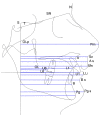Evaluation of Profile Changes in Class II Individuals Treated by Means of Herbst Miniscope Appliance
- PMID: 32244893
- PMCID: PMC7175301
- DOI: 10.3390/dj8010027
Evaluation of Profile Changes in Class II Individuals Treated by Means of Herbst Miniscope Appliance
Abstract
Background: To evaluate the profile changes following orthopedic/orthodontic treatment with the Herbst Miniscope® appliance in subjects affected with Class II malocclusion with mandibular retrusion.
Methods: A total of 44 patients presenting a skeletal Angle Class II malocclusion (ANB > 4°) due to mandibular retrusion and a cervical maturation stage between CS2 and CS3 were included in the study. Of these 44 patients, 22 (mean age 11.9 ± 1.3, HBT group) were treated using the Herbst appliance, while 22 (mean age 10.6 ± 1.3, CTR group) were followed for a 12-month observational period. A cephalometric tracing was performed at the beginning of treatment (T0) and after 12 months (T1).
Results: In both groups there was a significant advancement of soft tissue pogonion (HBT = 3.5 ± 3.0 mm, p < 0.001; CTR = 2.2 ± 2.9 mm, p < 0.001), but the difference between the two groups was not significant (p = 0.172). On the contrary, both groups had a significant advancement of the mandibular sulcus (HBT = 3.7 ± 2.8 mm, p < 0.001; CTR = 1.2 ± 2.2 mm, p < 0.001) and a lower lip protrusion (HBT = 3.45 ± 2.51 mm, p < 0.001; CTR = 1.7 ± 2.7 mm, p = 0.008), but in both cases the HBT group showed a statistically significant greater increase in sulcus protrusion (p = 0.002) and lower lip protrusion (p = 0.029) than controls. There were no statistically significant effects on the upper jaw.
Conclusions: The Herbst appliance advanced the lower jaw soft tissues.
Keywords: Herbst Miniscope; class II malocclusion; functional appliance; functional treatment; soft tissues.
Conflict of interest statement
The authors declare no conflict of interest.
Figures
References
LinkOut - more resources
Full Text Sources




